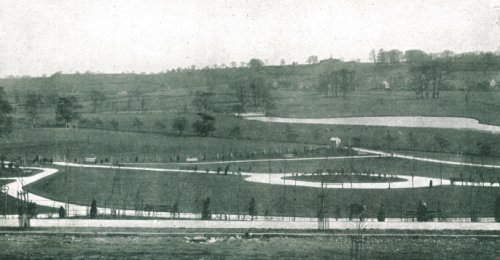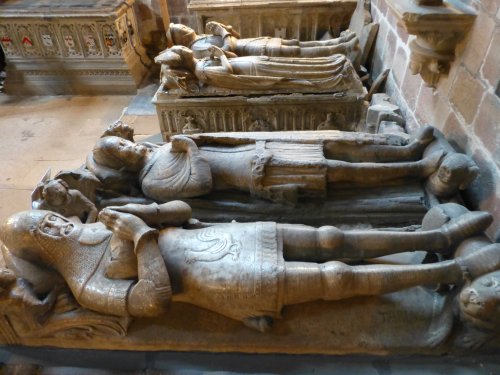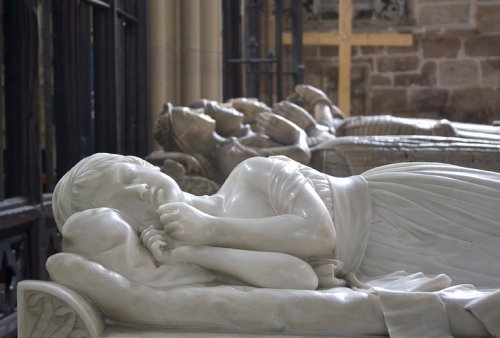In 1745 Bonnie Prince Charlie marched into Ashbourne on his way to take the crown in London. His troops camped in the grounds of Ashbourne Hall with the Pretender and his officers requisitioning the house as the Boothby’s, now Lords of the Manor, had ‘gone into the hills’.
Ashbourne Park would originally have been part of an ancient woodland and royal hunting ground which originally stretched some 12 miles to Duffield. The park became part of the Ashbourne Hall estate sometime after 1150 and remained as a deer park being shown on a map of 1547 as impaled (fenced). It is mentioned in the epitaph of Sir Thomas Cockayne, d 1537, in England’s oldest rhyming epitaph as one of three hunting parks created by Sir Thomas. His grandson, also Sir Thomas, wrote the first ‘Treatise on Hunting’ published in 1591.
In 1645 King Charles I came to Ashbourne on his way from the Battle of Naseby, he stayed the night at Ashbourne Hall being entertained by Lady Cockayne, her husband Sir Aston being away with the Royalist garrison at Tutbury Castle. It is recorded that the King ‘enjoyed his stay and took a turn around the gardens’. A hundred years later in 1745 Bonnie Prince Charlie marched into Ashbourne on his way to London in attempt to take the crown for his father. His troops camped in the grounds of Ashbourne Hall. The Pretender and his officers requisitioned the house as the Boothby’s, now Lords of the Manor, had ‘gone into the hills’.
In the 1790’s, when the Hall was leased to the Leigh family - visitors where ‘entertained with boat trips on the lake to a small island’. The area having been developed as an ornamental pleasure park by the Boothby’s in the late 17th Century, and further enlarged in 1784 when Brooke Boothby started to improve the park with extensive planting and rebuilding of the hall. The fishponds were reshaped into ornamental lakes and the park landscaped with trees, especially to screen the house from traffic on the newly created Ashbourne to Derby turnpike road on Derby Hill. The remaining lake, still known as the Fishpond, is the most westerly of Boothby's creations.
By 1910 the Hall had become a hotel and the park was again part of the playing area for Shrovetide football which it remains to this day, excluding the Memorial Gardens, with much ‘water play’ in and around the Henmore Brook and the Fishpond. In 1922 the estate was sold off with much of the ornamental gardens becoming municipal housing, a new road built across the front of the Hall and the remainder of the estate becoming the Memorial Park and recreation grounds. The war memorial gates were unveiled on Wednesday May 10th 1922 by Brian Cockayne, the Rt. Hon Baron Cullen of Ashbourne. The 1950’s saw the construction of a Sports Pavilion in honour of those who lost their lives during the two world wars and a bandstand and ornamental shelter were also added - features which are now reaching the end of their useful life.Early members of the Cokayne family were tied to the House of Lancaster and occupied the manor of Ashbourne. Later generations served the Tudors. In particular Sir Thomas Cokayne (d. 1537) was knighted by Henry VIII at the Battle of Tournay in 1513. He was styled the 'magnificent' and was present at the Field of the Cloth of Gold in 1520 where King Henry VIII and King Francis I of France tried to outdo each other in displaying extravagance. Sir Thomas was a keen huntsman. This is referred to in his epitaphs which includes: Two goodly houses he did build to his great praise and fame With profitte greate and manifold belonging to the same. Three Parkes empaled eke wherein to chace his deere, Aloft the Lodge within this Parke he also builded heere. This epitaph is very significant for Ashbourne as it refers to the lodge built within the Park. The family had two main estates, the one in Ashbourne and the other at Pooley in Warks. These must be the locations of the two ‘goodly houses’ and two of the parks. We now know now that it is he who built the house and laid out the park for hunting deer. Sir Thomas' grandson, also Sir Thomas was the author of A Short Treatise on Hunting published in 1591.
The Boothbys bought the Ashbourne estate in the late 1600s and made alterations and additions. These additions and alterations were likely to have been done on the instructions of Sir Brooke Boothby, 4th Bt., in the 1780s. James Pilkington writing in 1789 in A view of the present state of Derbyshire: commented that he ‘has made and is still making considerable improvements in the house and the ground about it’. This included diverting the road to Wirksworth from passing in front of the house to passing to the rear. Lime trees were then planted on the west and north boundaries to secure privacy. The trees formed an avenue known as Lady Cokayne’s Walk. The fishponds had been used as a source of fish for the household. In 1755 Brooke Boothby offered a reward for information leading to the arrest of the person(s) who had stolen carp out of the pond. Work was done to landscape the Park including making ornamental ponds with an island and diverting the Henmore. The identity of the designer is unknown. The diversion of the Henmore can be seen by comparing the 1547 with that of 1830. Although the 1547 map cannot be taken as accurate, it does not have the two very unnatural right angled bends that can be seen in the 1830 map. These are likely to be the result of the landscaping works.
On May 10th 1922 part of the park closest to the hall was dedicated as a Memorial Garden to the dead of the First World War. The Recreation Ground was divided into two parts; one portion was intended to be used as a Sports Ground, and Children’s Playground, and the remainder was been laid out as Ornamental Gardens, with winding paths from the Memorial Arch leading to the sports ground, and other walks. A statue commemorating the life of Catherine Booth, co-founder of the Salvation Army, who was born in the town, has also been erected in the park.
The Cockayne family were effectively 'Lords of the Manor' from 1340's to 1671. Their tombs in St Oswald's church form one of the finest family collections in the County and Country.
The Boothby family bought Ashbourne Hall in 1671. They landscaped the Park substantially, including diverting the Henmore and closing the Wirksworth road. The tomb of Penelope Boothby in St Oswald's church is renown.
In 1745 Bonnie Prince Charlie declared his father to be King James III in Ashbourne Market Place. His troops were billeted in Ashbourne Park.
Catherine Booth was wife of General William Booth and co-founder of the Salvation Army. She was born at 13 Sturston Lane (now Road), Ashbourne in 1829. There is a bust to her in Ashbourne Park.
























